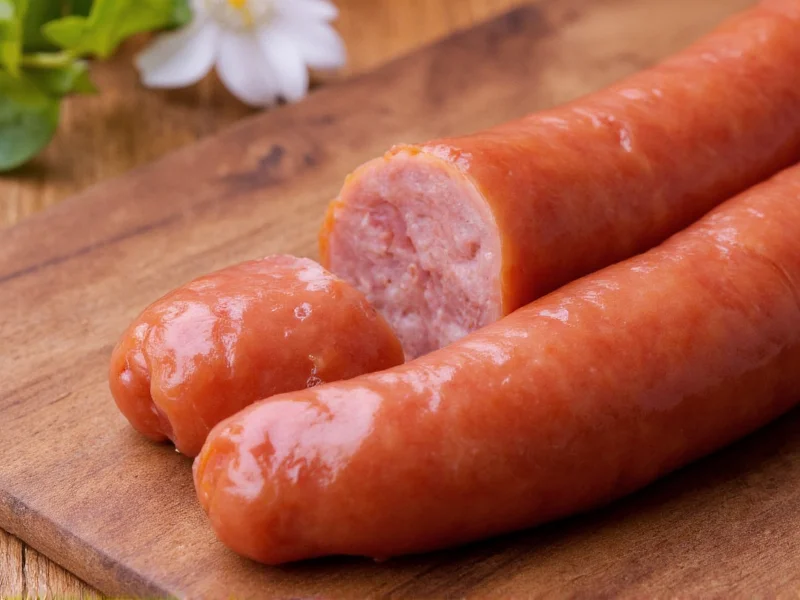Sausage casings serve as the essential outer layer that shapes and contains sausage meat during preparation and cooking. Understanding the different types helps both home cooks and professional butchers select the right option for their specific needs.
Natural Casings: The Traditional Choice
Natural casings, derived from the submucosa layer of animal intestines (typically from pigs, sheep, or cattle), have been used for centuries in sausage making. These edible membranes provide that distinctive "snap" when biting into a quality sausage and allow smoke and seasonings to penetrate effectively during cooking.
Pork casings (typically 32-35mm diameter) work well for bratwurst and Italian sausages. Sheep casings (24-28mm) are ideal for smaller links like breakfast sausages, while beef casings (36mm+) suit larger sausages including salami and bologna. Before use, natural casings require thorough rinsing and soaking in lukewarm water to remove excess salt and restore flexibility.
Synthetic Casing Options
Modern sausage production utilizes several synthetic alternatives that address specific commercial needs:
| Casing Type | Material | Best For | Edible? |
|---|---|---|---|
| Natural | Animal intestine | Artisanal sausages, smoked productsYes | |
| Collagen | Processed animal collagen | Fresh sausages, portion controlYes (small diameters) | |
| Cellulose | Plant fiber | Smoked sausages, hot dogsNo (peeled before eating) | |
| Fibrous | Cellulose with fibrous reinforcement | Large-diameter cooked sausagesNo |
Collagen Casings: The Popular Alternative
Manufactured from processed animal collagen (usually bovine hides), collagen casings offer consistent diameter and ease of use. Available in edible forms for fresh sausages (typically under 32mm) and non-edible forms for larger products, they've become the industry standard for many commercial operations. When considering what are sausage casings made of in modern production, collagen represents the most common synthetic option due to its reliability and food safety profile.
Cellulose and Fibrous Casings
Cellulose casings, derived from plant fibers, provide excellent smoke and seasoning absorption for products like hot dogs. These require peeling after cooking. Fibrous casings add strength for larger products like summer sausage and pepperoni, with their distinctive textured appearance. Both options solve specific production challenges that natural casings can't address consistently at scale.
Vegetarian and Vegan Casing Solutions
For plant-based sausages, manufacturers use specialized casings made from alginate (seaweed extract) or other plant-derived materials. These edible sausage casing options for meat alternatives have improved significantly in recent years, though they still present different handling characteristics compared to traditional casings. Home cooks experimenting with vegetarian sausages often find collagen casings work reasonably well with dense plant-based fillings.
Practical Considerations for Home Sausage Makers
When selecting casings for homemade sausages, consider these factors:
- Diameter - Match casing size to your sausage stuffer tube and desired link size
- Preparation time - Natural casings require more preparation than ready-to-use collagen
- Flavor impact - Natural casings contribute subtle flavor notes that synthetics don't
- Storage - Salt-packed natural casings last years refrigerated; collagen has shorter shelf life
For beginners exploring how to use sausage casings at home, collagen casings offer the easiest starting point. Simply rinse, soak briefly in water, and thread onto your stuffer tube. Natural casings require more patience but reward with superior texture and traditional appearance.
Historical Context of Sausage Casings
The practice of using animal intestines as casings dates back to ancient Mesopotamia around 3100 BCE. Early butchers discovered that cleaned intestines provided the perfect natural container for preserving ground meat. This traditional method remained virtually unchanged until the 20th century when food scientists developed the first synthetic alternatives to address consistency and safety concerns in commercial production.
Selecting the Right Casing for Your Needs
The best casing for homemade sausages depends on your priorities:
- For authentic texture and flavor: Natural hog or sheep casings
- For consistent results with minimal preparation: Edible collagen
- For smoked products requiring peeling: Cellulose casings
- For large-diameter cooked sausages: Fibrous casings
Professional sausage makers often maintain relationships with specialized suppliers when determining where to buy sausage casings for commercial production. Home enthusiasts can find quality casings through kitchen supply stores, online retailers, and some butcher shops.
Frequently Asked Questions
Are sausage casings edible?
Most natural casings and small-diameter collagen casings are edible and meant to be eaten. Cellulose and fibrous casings used for larger products like hot dogs and summer sausage are not edible and must be removed before consumption.
How do I prepare natural sausage casings?
Rinse salt-packed natural casings thoroughly under cold water, then soak in lukewarm water for 30-60 minutes to remove excess salt and restore flexibility. Change the water several times during soaking. Before use, flush the casing tube with water to ensure it's clear of any particles.
What's the difference between collagen and cellulose casings?
Collagen casings are made from processed animal protein and are typically edible for fresh sausages. Cellulose casings are made from plant fibers and are primarily used for smoked products like hot dogs, requiring removal before eating. Collagen offers better texture for fresh sausages while cellulose provides superior smoke absorption.
Can I make sausages without casings?
Yes, you can make sausage patties or bulk sausage without casings. However, traditional link sausages require casings to maintain shape during cooking. Some home cooks use alternatives like parchment paper rolls for certain preparations, but this doesn't replicate the texture and cooking properties of proper sausage casings.
How long do unused casings last?
Properly stored salt-packed natural casings can last 2-3 years refrigerated. Pre-flushed natural casings in water last about 1 year refrigerated. Dry collagen casings typically remain usable for 12-18 months when stored in a cool, dark place. Always check for off odors or discoloration before use.











 浙公网安备
33010002000092号
浙公网安备
33010002000092号 浙B2-20120091-4
浙B2-20120091-4